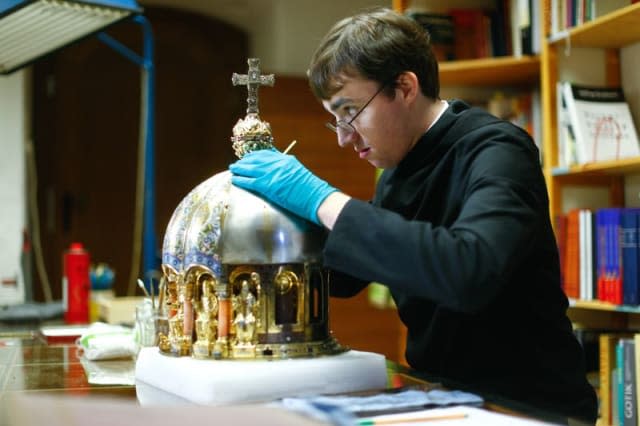German cathedral dusts off relics of St Corona, patron of epidemics

AACHEN, Germany (Reuters) - Germany's Aachen Cathedral has dug out the relics of little-known Saint Corona, patron saint of resisting epidemics, from its treasure chamber and is polishing up her elaborate shrine to go on show once the coronavirus pandemic has passed.
The pandemic, confirmed to have infected nearly half a million people worldwide, including more than 30,000 in Germany, has boosted public interest in the Christian martyr, believed to have been killed by the Romans around 1,800 years ago.
The cathedral had planned even before the coronavirus outbreak to display St Corona's shrine this summer as part of an exhibition on gold craftsmanship. It is not clear when people will now be able to view the shrine due to tough restrictions on gatherings imposed to help combat the spread of the virus.

But experts are painstakingly cleaning the gold, bronze and ivory shrine, which has been hidden from public view for the last 25 years, in preparation for when it can go on display.
"We have brought the shrine out a bit earlier than planned and now we expect more interest due to the virus," said Aachen Cathedral spokeswoman Daniela Loevenich.
Corona is believed to have been only about 16 years old when the Romans killed her, probably in Syria, for professing the Christian faith.
The girl suffered a particularly excruciating death, according to legend. She was tied to two bent palm trees and then torn apart as the trunks were released.
"That is a very gruesome story and led to her becoming the patron of lumberjacks," said Brigitte Falk, head of Aachen Cathedral Treasure Chamber, adding that it was pure chance that she also became a patron saint for resisting epidemics.
Corona's relics, brought to Aachen by King Otto III in 997, were kept in a tomb underneath a slab in the cathedral - which can still be seen - until 1911-12 when they were placed in the shrine, which is 93 centimetres tall and weighs 98 kilograms.
The Roman Catholic cathedral at Aachen, built by Emperor Charlemagne in the ninth century, is one of Europe's oldest. Charlemagne was buried there in 814 and it was used for the coronation of German kings and queens.
While the cathedral stresses that Corona is patron saint of resisting all epidemics, not just this specific virus, the virus is so called because under a microscope, it looks like a globe with little globules, resembling a crown, said Falk. In Latin corona means crown or garland.
"Like many other saints, Saint Corona may be a source of hope in these difficult times," said Falk.



